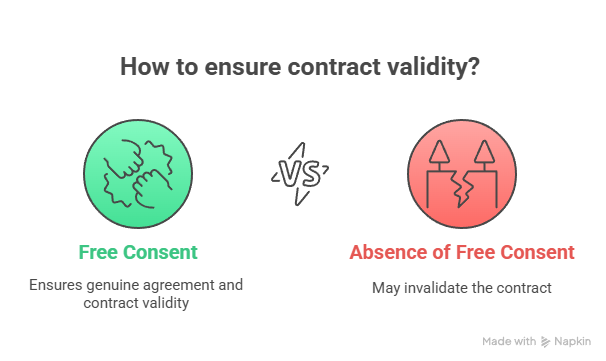So you’re entering into a contract. You’ve got your offer. The other person accepted. Maybe the money’s involved. Maybe it’s services. Great! But before you think the deal is sealed, there’s one crucial element that can make or break the entire agreement.
Free and consent.
It sounds straightforward—after all, you both agreed, right? But under Indian law, the word “consent” carries serious weight. Not all agreements are created equal. If someone was forced, misled, or confused when they said “yes,” that consent might not hold up in court.
Let’s dig into what free consent means, why it’s so important, and what the Indian Contract Act, 1872 (Sections 13 to 19) says about it. We’ll also walk through every possible way consent can go wrong, using examples you can relate to.

What Does “Free Consent” Mean?
According to Section 13 of the Indian Contract Act, two people consent when they agree upon the same thing in the same sense—what’s known in legal terms as a “meeting of minds.”
But Section 14 takes it a step further: consent is free only if it is not caused by:
- Coercion
- Undue influence
- Fraud
- Misrepresentation
- Mistake
If any of these factors are present, the contract is either voidable (one party can cancel it) or outright void (as if it never existed). Let’s unpack each of these.
1. Coercion (Section 15)
What it means: Coercion is when someone is forced into an agreement through threats, violence, or unlawful pressure.
Example:
A landlord tells his tenant, “Sign this lease renewal at double the rent or I’ll throw your belongings out tonight.”
This is coercion. The tenant’s consent isn’t voluntary—it’s fear-based.
Legally speaking, coercion includes:
- Committing or threatening to commit any act forbidden by law (like blackmail or assault)
- Unlawful detaining of property
If a contract is signed under coercion, the affected party can cancel it.
2. Undue Influence (Section 16)
What it means: This occurs when one party uses their position of power or trust to dominate the other’s will and gain an unfair advantage.
Example:
A caregiver pressures an elderly person to sign over property rights by playing on their emotional dependence.
That’s undue influence—because of the imbalance in power and trust.
This is especially common in relationships like:
- Parent–child
- Teacher–student
- Lawyer–client
- Doctor–patient
In such cases, the law assumes influence exists, and the burden is on the dominant party to prove there was no undue influence.
3. Fraud (Section 17)
What it means: Fraud is when someone intentionally deceives another person to enter into a contract. This isn’t just exaggeration—it’s a deliberate lie or concealment of facts.
Example:
A builder tells a client, “This flat has all the permits,” when he knows it’s illegal construction.
That’s fraud. The client was tricked into agreeing.
Fraud can involve:
- Lying about facts
- Hiding material information
- Making promises with no intention to keep them
If fraud is proven, the innocent party can cancel the contract and may sue for damages.
4. Misrepresentation (Section 18)
What it means: This is similar to fraud, but with one major difference—there’s no intention to deceive. It happens when a false statement is made innocently, but it still misleads the other person.
Example:
A dealer tells a customer that a bike has never been in an accident, genuinely believing it’s true. Later, it turns out the bike had major repairs.
That’s misrepresentation.
The person affected can void the contract, but damages usually aren’t awarded unless there’s actual loss or negligence.
5. Mistake (Sections 20 to 22)
What it means: Sometimes, both parties enter into a contract under a misunderstanding about an essential fact. This is called a mistake of fact.
Example:
Two people sign a contract to sell a ship, believing it’s on its way to India. Unknown to both, the ship had already sunk before they signed.
This is a mutual mistake—the contract is void.
There are two kinds of mistake:
- Mutual mistake (both parties are mistaken): the contract is void.
- Unilateral mistake (only one party is mistaken): the contract usually remains valid, unless the mistake is about the nature of the agreement or the identity of the other party.
Why Free Consent Matters
Here’s the bottom line: a contract is only as strong as the consent it’s built on.
It doesn’t matter if the document is signed and stamped—if consent was flawed, the whole agreement can fall apart in court. And rightly so. The law protects individuals from being tricked, pressured, or taken advantage of.
In our previous post, we saw Aman (a freelance designer) offer branding services to Bharat (a restaurant owner) for ₹25,000. Bharat agreed, and everything seemed smooth.
But what if Bharat had been tricked into believing Aman was a celebrity designer? Or if Aman had emotionally pressured Bharat into accepting the deal by saying, “If you don’t help me, I’ll lose my home”?
In those situations, consent wouldn’t be free, and the contract could be challenged.
But in our example, neither party was misled, forced, or manipulated. They discussed terms, understood each other clearly, and agreed willingly. That’s free consent—just as the law requires.
If you remember one thing from this article, let it be this:
Consent is not just saying “yes.” It’s saying “yes” for the right reasons, with the full picture in mind.
The Indian Contract Act doesn’t just protect paperwork—it protects people. So the next time you enter into a contract—whether as a freelancer, client, landlord, or vendor—make sure both sides are on the same page, with no pressure, no tricks, and no confusion.




